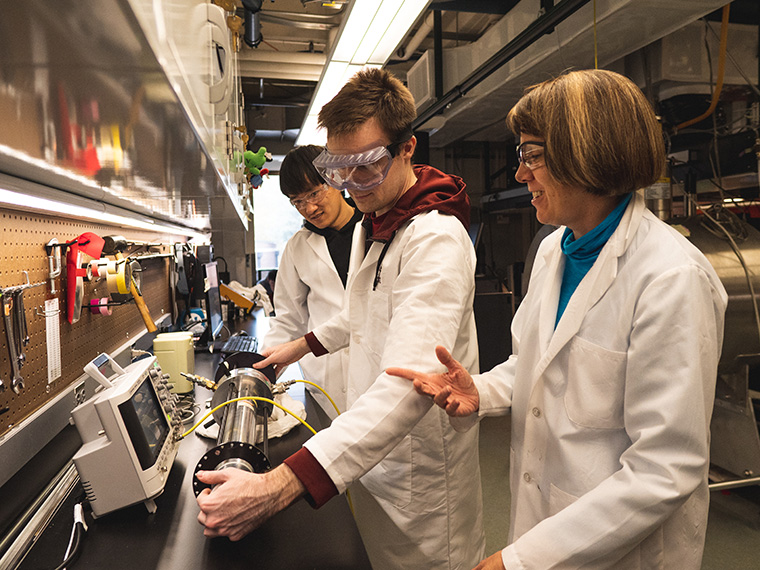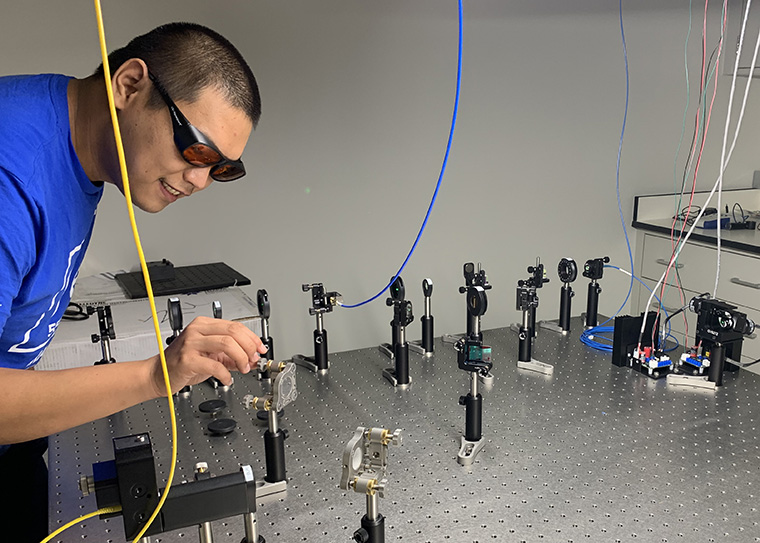NSF funds training program to boost regional quantum workforce
Five-year effort connects research, training at local universities and companies

The National Science Foundation (NSF) is investing $3 million in a new graduate student training program for aspiring scientists and educators who want to explore careers in quantum science at St. Louis-area research laboratories, private companies and other facilities.
Sophia Hayes, vice dean of graduate education and professor of chemistry, and Kater Murch, professor of physics, both in Arts & Sciences at Washington University in St. Louis, will lead the effort to establish a convergent quantum sciences and engineering graduate training program across the St. Louis region, “Linking Quantum Sensing Technologies across Disciplines,” or LinQ-STL.
Erik Henriksen, associate professor of physics in Arts & Sciences, and Sheretta Butler-Barnes, associate professor at the Brown School, will work with Hayes and Murch as co-principal investigators on the five-year project. Engineers with the McKelvey School of Engineering, including co-investigator Matthew Lew, associate professor in the Preston M. Green Department of Electrical & Systems Engineering, also will be involved in the program.
LinQ-STL will connect research efforts between Washington University, the University of Missouri-St. Louis, Saint Louis University and Harris-Stowe State University. The grant is part of NSF’s signature research traineeship program; LinQ-STL is one of two awards in Missouri in 2022 (the other program will be led by the University of Missouri-Kansas City).

“Our team will address quantum sensing, which is an area that requires detailed knowledge of physics, chemistry and engineering to come together to achieve new methods for detection — beyond classical physics,” Hayes said. “We see this as an opportunity to develop a network of researchers and companies in the St. Louis region, which will benefit from a trained and prepared interdisciplinary workforce — graduate students who can help elevate the development of these emerging technologies and the profile of this type of science to benefit the region.”
“Our approach is inspired by the kinds of experiences our students are having in physics, where a student who is just finishing their PhD has a chance to jump to a different project or different collaboration,” Murch explained.
That new placement — a temporary but often very fruitful one in terms of technology or skills transfer — could take place at another university in the St. Louis area or even within private industry. Murch and Henriksen mentioned a recent example of a graduate student who successfully completed an immersive project experience at a local Boeing facility.
Another training track within the new LinQ-STL program would allow graduate students who are interested in education or technology transfer to complete an internship at Washington University’s Center for Teaching and Learning, Office of Technology Management or at a variety of national labs and industrial partner labs.
“This is a completely different way to think about graduate training,” Murch said. “Typically, graduate students take classes and learn techniques in their first few years and then become immersed in research. Our plan is to take graduate students at the end of their PhD — when they are absolute experts in their specific subtopic, a key point of their early scientific career — and help them forge new interdisciplinary connections with another research group, to leverage their expertise and give them new experiences.”
The project anticipates training 100 students, including 40 funded trainees from chemistry, physics, computer science, electrical engineering and system engineering doctorate programs.
The effort is focused on quantum sensors, which rely on the unique physical properties of nature at the atomic and subatomic scales to detect phenomena that evade identification in the human-scaled realm of lived experience. As such quantum behavior finds increasingly more applications, there is a growing need for a workforce prepared to discover, develop and deploy the science and engineering advancements in this emerging field.
Further, the project’s investigators seek to create institutional change in graduate education by demonstrating how career-building internships and experiences aligned with students’ professional interests can influence their career trajectories and success.
For example, one task that underlies the entire LinQ-STL effort is probing how trainees perceive themselves as science learners. By exploring how LinQ-STL trainees build their identities — including their science identity, racial and gender identity and efficacy beliefs — researchers hope to identify new ways to diversify the scientific workforce and enable students to become the next generation of leaders and teachers.
In announcing the award, the NSF said that quantum information science and engineering is a national priority of utmost importance.
“NSF continues to invest in the future STEM workforce by preparing trainees to address challenges that increasingly require crossing traditional disciplinary boundaries,” Sylvia Butterfield, acting assistant director for NSF’s Directorate for Education and Human Resources, said in an announcement. “Supporting innovative and evidence-based STEM graduate education with an emphasis on recruiting and retaining a diverse student population is critical to ensuring a robust and well-prepared STEM workforce.”


